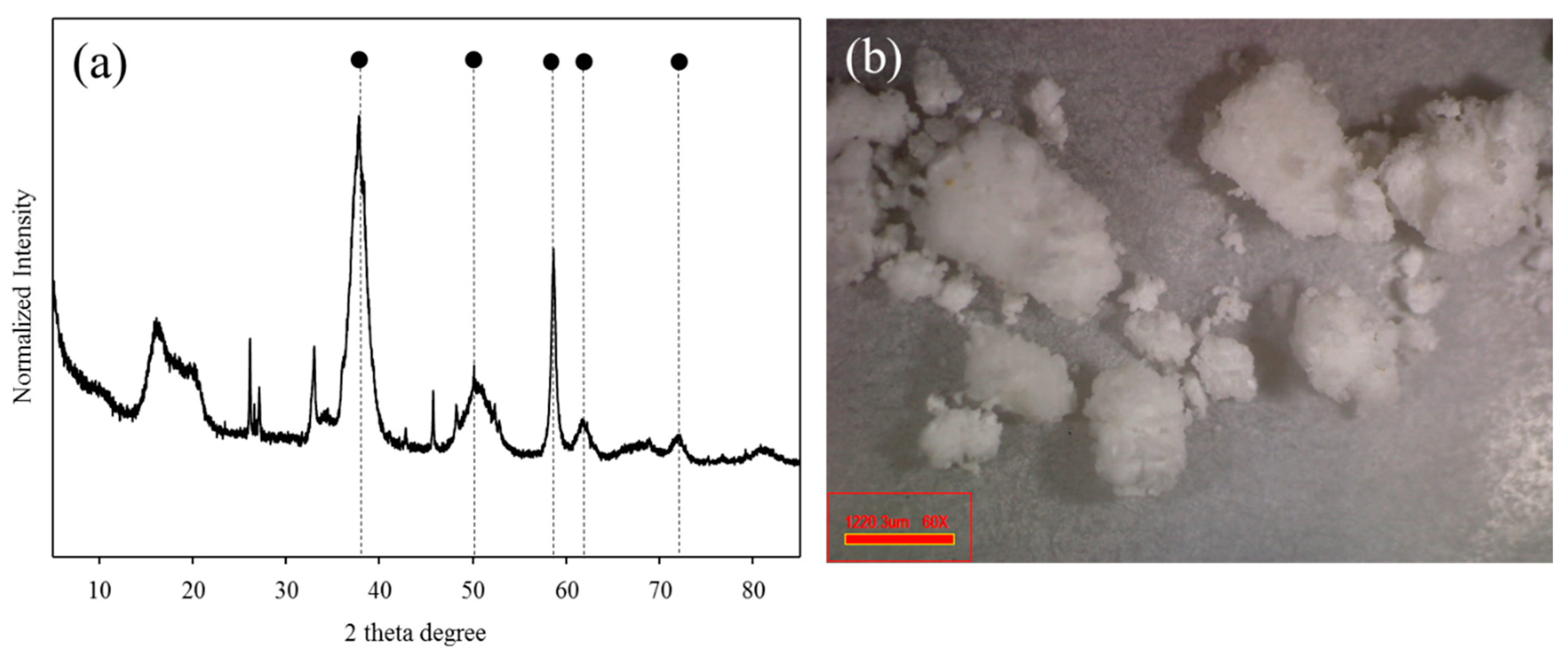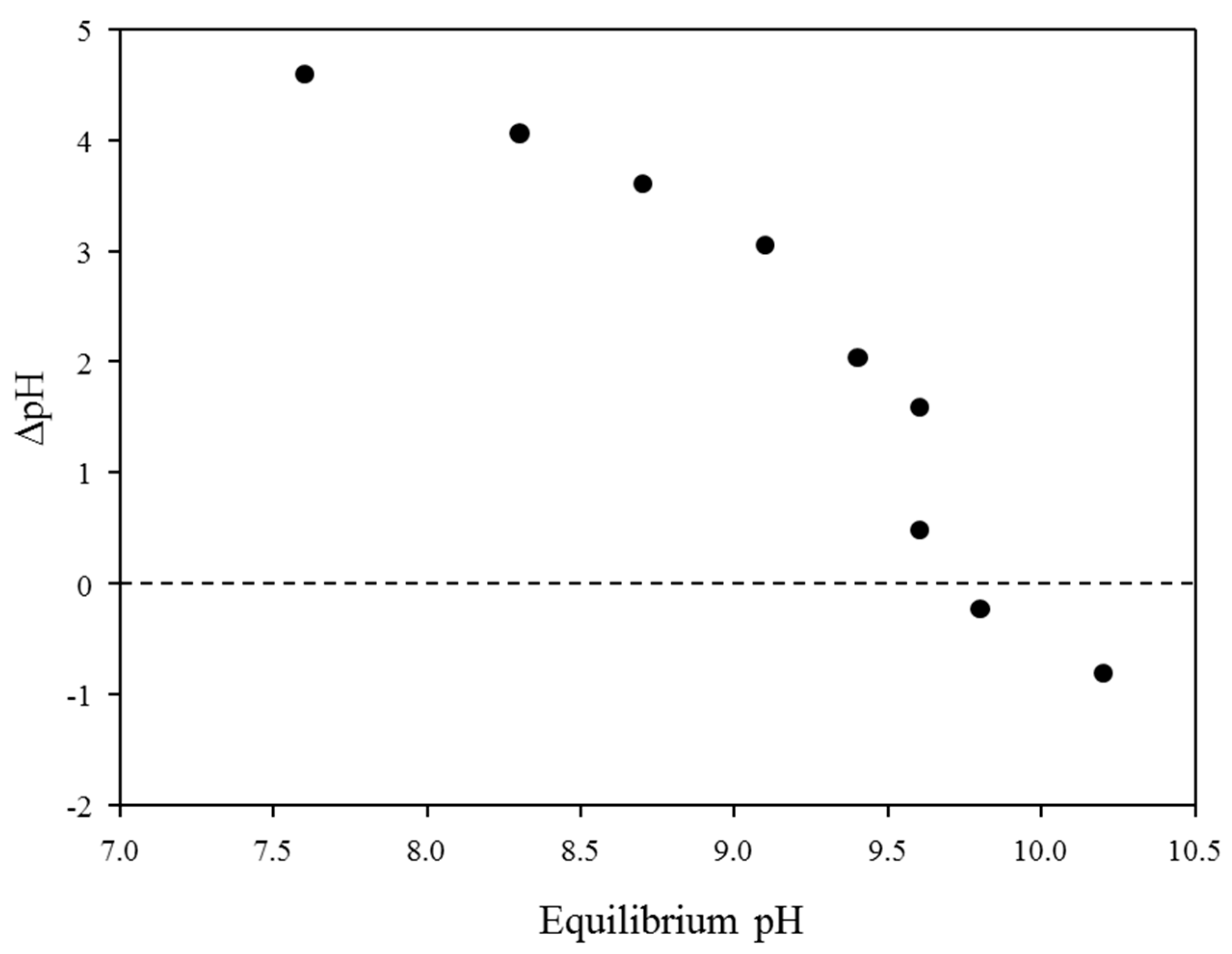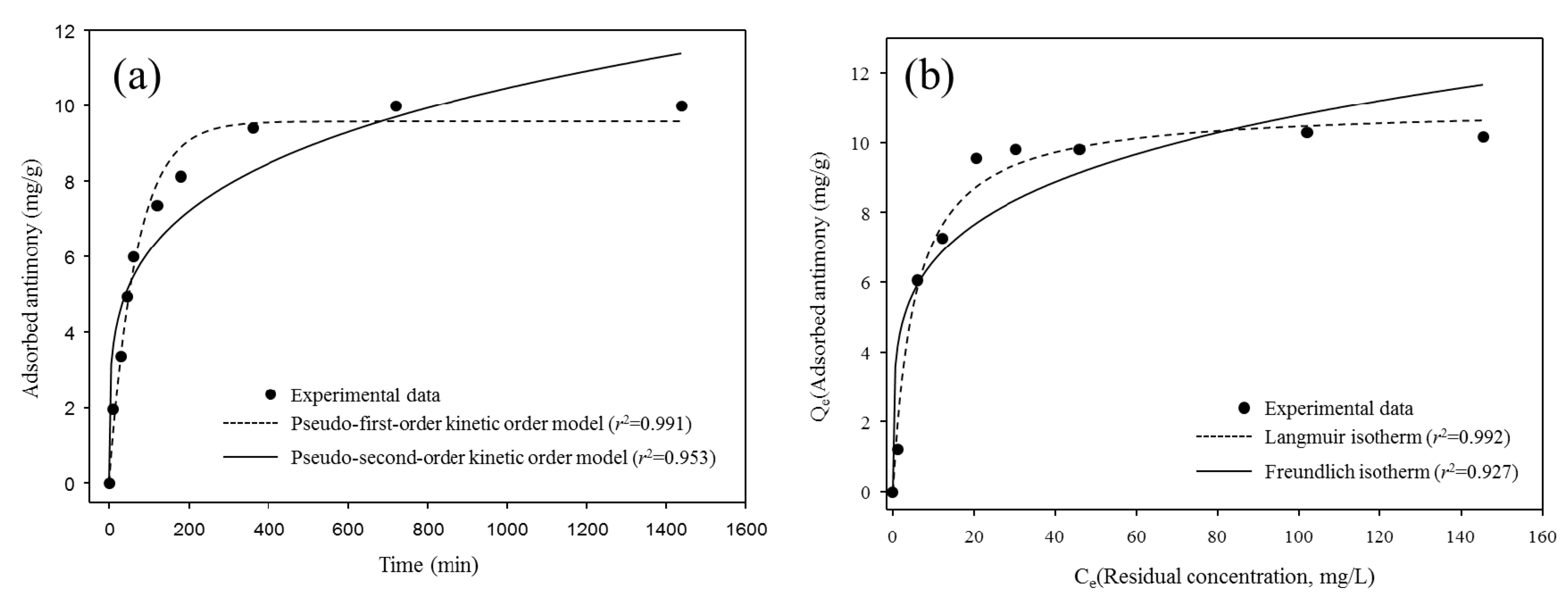Selective Immobilization of Antimony Using Brucite-rich Precipitate Produced during In Situ Hypochlorous Acid Formation through Seawater Electrolysis in a Nuclear Power Plant
Abstract
:1. Introduction
2. Materials and Methods
2.1. Collection of Brucite-Rich Precipitate (BP)
2.2. Characterization of BP
2.3. Adsorption Studies
3. Results and Discussion
3.1. Mineralogical Characteristics of BP
3.2. Identification of New Mineral Deposits with Antimony
3.3. Adsorption Studies
3.4. Kinetic and Isotherm Studies
4. Conclusions
Author Contributions
Funding
Conflicts of Interest
References
- Shtangeeva, I.; Bali, R.; Harris, A. Bioavailability and toxicity of antimony. J. Geochem. Explor. 2011, 110, 40–45. [Google Scholar] [CrossRef]
- Sundar, S.; Chakravarty, J. Antimony toxicity. Int. J. Environ. Res. Public Health 2010, 7, 4267–4277. [Google Scholar] [CrossRef] [PubMed]
- Filella, M.; Belzile, N.; Chen, Y.W. Antimony in the environment: A review focused on natural waters I. Occurence. Earth-Sci. Rev. 2002, 57, 125–176. [Google Scholar] [CrossRef]
- US EPA. Antimony: An Environmental and Health Effects Assessment; US EPA: Washington, DC, USA, 1984. [Google Scholar]
- Lee, S.H.; Choi, H.; Kim, K.W. Removal of As(V) and Sb(V) in water using magnetic nanoparticle-supported layered double hydroxide nanocomposites. J. Geochem. Explor. 2018, 184, 247–254. [Google Scholar] [CrossRef]
- Kolbe, F.; Weiss, H.; Morgenstern, P.; Wennrich, R.; Lorenz, W.; Schurk, K.; Stanjek, H.; Daus, B. Sorption of aqueous antimony and arsenic species onto akaganeite. J. Colloid Interface Sci. 2011, 357, 460–465. [Google Scholar] [CrossRef]
- Lu, H.; Zhu, Z.; Zhang, H.; Zhu, J.; Qiu, Y. Simultaneous removal of arsenate and antimonate in simulated and practical water samples by adsorption onto Zn/Fe layered double hydroxide. Chem. Eng. J. 2015, 276, 365–375. [Google Scholar] [CrossRef]
- Qi, Z.; Lan, H.; Joshi, T.P.; Liu, R.; Liu, H.; Qu, J. Enhanced oxidative and adsorptive capability towards antimony by copper-doping into magnetite magnetic particles. RSC Adv. 2016, 6, 66990–67001. [Google Scholar] [CrossRef]
- Wu, F.; Fu, Z.; Liu, B.; Mo, C.; Chen, B.; Corns, W.; Liao, H. Health risk associated with dietary co-exposure to high levels of antimony and arsenic in the world’s largest antimony mine area. Sci. Total Environ. 2011, 409, 3344–3351. [Google Scholar] [CrossRef]
- Kameda, T.; Nakamura, M.; Yoshioka, T. Removal of antimonate ions from an aqueous solution by anion exchange with magnesium-aluminum layered double hydroxide and the formation of a brandholzite-like structure. J. Environ. Sci. Health. A Tox. Hazard. Subst. Environ. Eng. 2012, 47, 1146–1151. [Google Scholar] [CrossRef]
- Kameda, T.; Honda, M.; Yoshioka, T. Removal of antimonate ions and simultaneous formation of a brandholzite-like compound from magnesium-aluminum oxide. Sep. Purif. Technol. 2011, 80, 235–239. [Google Scholar] [CrossRef]
- Lee, S.-H.; Tanaka, M.; Takahashi, Y.; Kim, K.-W. Enhanced adsorption of As(V) and Sb(V) by calcined Mg/Al layered double hydroxide: Investigation of comparative adsorption mechanism by surface characterization. Chemosphere 2018, 211, 903–911. [Google Scholar] [CrossRef]
- Friedrich, A.; Wildner, M.; Tillmanns, E.; Merz, P.L. Crystal chemistry of the new mineral brandholzite, Mg(H2O)6[Sb(OH)6]2, and of the synthetic analogues M2+(H2O)6[Sb(OH)6]2 (M2+ = Mg, Co). Am. Mineral. 2000, 85, 593–599. [Google Scholar] [CrossRef]
- Tanaka, K.; Kozai, N.; Ohnuki, T.; Grambow, B. Study on coordination structure of Re adsorbed on Mg-Al layered double hydroxide using X-ray absorption fine structure. J. Porous Mater. 2019, 26, 505–511. [Google Scholar] [CrossRef]
- Cai, P.; Zheng, H.; Wang, C.; Ma, H.; Hu, J.; Pu, Y.; Liang, P. Competitive adsorption characteristics of fluoride and phosphate on calcined Mg-Al-CO3 layered double hydroxides. J. Hazard. Mater. 2012, 213–214, 100–108. [Google Scholar] [CrossRef]
- Goh, K.H.; Lim, T.T.; Dong, Z. Application of layered double hydroxides for removal of oxyanions: A review. Water Res. 2008, 42, 1343–1368. [Google Scholar] [CrossRef] [PubMed]
- Wang, Q.; Ohare, D. Recent advances in the synthesis and application of layered double hydroxide (LDH) nanosheets. Chem. Rev. 2012, 112, 4124–4155. [Google Scholar] [CrossRef]
- Mohan, D.; Pittman, C.U. Arsenic removal from water/wastewater using adsorbents—A critical review. J. Hazard. Mater. 2007, 142, 1–53. [Google Scholar] [CrossRef]
- Ahmaruzzaman, M. Industrial wastes as low-cost potential adsorbents for the treatment of wastewater laden with heavy metals. Adv. Colloid Interface Sci. 2011, 166, 36–59. [Google Scholar] [CrossRef]
- Wang, Y.R.; Tsang, D.C.W.; Olds, W.E.; Weber, P.A. Utilizing acid mine drainage sludge and coal fly ash for phosphate removal from dairy wastewater. Environ. Technol. 2013, 34, 3177–3182. [Google Scholar] [CrossRef]
- Chen, S.; Zhu, J.; Wang, B.; Liu, H.; He, B. Experimental study on hypochlorous acid blocking the marine diatom adhesion. Int. J. Electrochem. Sci. 2012, 7, 5331–5338. [Google Scholar]
- Sandvik, E.L.; McLeod, B.R.; Parker, A.E.; Stewart, P.S. Direct electric current treatment under physiologic saline conditions kills staphylococcus epidermidis biofilms via electrolytic generation of hypochlorous acid. PLoS ONE 2013, 8, e55118. [Google Scholar] [CrossRef] [PubMed]
- Schwartz, A.M. Solutions and solution properties. In Handbook of Industrial Crystallization; Elsevier: Amsterdam, The Netherlands, 2002; Volume 7, Chapter 1; pp. 1–31. [Google Scholar] [CrossRef]
- Zheng, L.; Xuehua, C.; Mingshu, T. Hydration and setting time of MgO-type expansive cement. Cem. Concr. Res. 1992, 22, 1–5. [Google Scholar] [CrossRef]
- Wang, X.; Pang, H.; Chen, W.; Lin, Y.; Ning, G. Controllable fabrication of high purity Mg(OH)2 nanoneedles via direct transformation of natural brucite. Mater. Lett. 2014, 120, 69–72. [Google Scholar] [CrossRef]
- Pokrovsky, O.S.; Schott, J. Experimental study of brucite dissolution and precipitation in aqueous solutions: Surface speciation and chemical affinity control. Geochim. Cosmochim. Acta 2004, 68, 31–45. [Google Scholar] [CrossRef]
- Lee, S.-H.; Kim, K.-W.; Lee, B.-T.; Bang, S.; Kim, H.; Kang, H.; Jang, A. Enhanced arsenate removal performance in aqueous solution by yttrium-based adsorbents. Int. J. Environ. Res. Public Health 2015, 12, 13523–13541. [Google Scholar] [CrossRef] [PubMed]
- Bacelo, H.; Vieira, B.R.C.; Santos, S.C.R.; Boaventura, R.A.R.; Botelho, C.M.S. Recovery and valorization of tannins from a forest waste as an adsorbent for antimony uptake. J. Clean. Prod. 2018, 198, 1324–1335. [Google Scholar] [CrossRef]
- Yu, Y.; Yu, L.; Wang, C.; Chen, J.P. An innovative yttrium nanoparticles/PVA modified PSF membrane aiming at decontamination of arsenate. J. Colloid Interface Sci. 2018, 530, 658–666. [Google Scholar] [CrossRef]
- Tang, M.; Chen, J.; Wang, P.; Wang, C.; Ao, Y. Highly efficient adsorption of uranium(VI) from aqueous solution by a novel adsorbent: Titanium phosphate nanotube. Environ. Sci. Nano 2018. [Google Scholar] [CrossRef]
- Lee, S.-H.; Takahashi, Y. Carbothermal preparation of magnetic-responsible ferrihydrite based on Fe-rich precipitates for immobilization of arsenate and antimonate: Batch and spectroscopic studies. Chemosphere 2019, 237, 124489. [Google Scholar] [CrossRef]
- Diquattro, S.; Garau, G.; Lauro, G.P.; Silvetti, M.; Deiana, S.; Castaldi, P. Municipal solid waste compost as a novel sorbent for antimony(V): Adsorption and release trials at acidic pH. Environ. Sci. Pollut. Res. 2018, 25, 5603–5615. [Google Scholar] [CrossRef]
- Mayakaduwa, S.S.; Kumarathilaka, P.; Herath, I.; Ahmad, M.; Al-Wabel, M.; Ok, Y.S.; Usman, A.; Abduljabbar, A.; Vithanage, M. Equilibrium and kinetic mechanisms of woody biochar on aqueous glyphosate removal. Chemosphere 2016, 144, 2516–2521. [Google Scholar] [CrossRef] [PubMed]






| Na | Mg | Al | Ca | S | Cl | |
|---|---|---|---|---|---|---|
| wt. (%) | 8.6 | 72.5 | 2.5 | 0.8 | 0.8 | 14.7 |
| Pseudo-First-Order Kinetic (ln (Qe − Qt) = lnQe − k1t) | Pseudo-Second-Order Kinetic (t/Qt = 1/k2Qe2 + t/Qe) | ||||
|---|---|---|---|---|---|
| Qe (mg/g) | k1 (min−1) | R2 | Qe (mg/g) | k2 (g mg−1 min−1) | R2 |
| 9.739 | 9.7 × 10−2 | 0.991 | 7.960 | 1.4 × 10−1 | 0.953 |
| Langmuir Isotherm (KL Qmax Ce/(1 + KL Ce)) | Freundlich Isothemr (KF Ce1/n) | ||||
|---|---|---|---|---|---|
| Qmax (mg/g) | KL (L/mg) | R2 | KF | n | R2 |
| 11.02 | 0.187 | 0.992 | 4.405 | 4.708 | 0.927 |
© 2020 by the authors. Licensee MDPI, Basel, Switzerland. This article is an open access article distributed under the terms and conditions of the Creative Commons Attribution (CC BY) license (http://creativecommons.org/licenses/by/4.0/).
Share and Cite
Lee, K.-H.; Lee, Y.-G.; Shin, J.; Chon, K.; Lee, S.-H. Selective Immobilization of Antimony Using Brucite-rich Precipitate Produced during In Situ Hypochlorous Acid Formation through Seawater Electrolysis in a Nuclear Power Plant. Energies 2020, 13, 4493. https://doi.org/10.3390/en13174493
Lee K-H, Lee Y-G, Shin J, Chon K, Lee S-H. Selective Immobilization of Antimony Using Brucite-rich Precipitate Produced during In Situ Hypochlorous Acid Formation through Seawater Electrolysis in a Nuclear Power Plant. Energies. 2020; 13(17):4493. https://doi.org/10.3390/en13174493
Chicago/Turabian StyleLee, Kyung-Hee, Yong-Gu Lee, Jaegwan Shin, Kangmin Chon, and Sang-Ho Lee. 2020. "Selective Immobilization of Antimony Using Brucite-rich Precipitate Produced during In Situ Hypochlorous Acid Formation through Seawater Electrolysis in a Nuclear Power Plant" Energies 13, no. 17: 4493. https://doi.org/10.3390/en13174493





